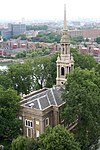King Edward Memorial Park
Parks and open spaces in the London Borough of Tower HamletsParks and open spaces on the River ThamesUse British English from June 2015Wapping

King Edward Memorial Park is a public open space in the London Borough of Tower Hamlets, on the northern bank of the River Thames. It was opened in 1922 in memory of King Edward VII. With an area of 3.3 hectares, it is the 11th largest park in Tower Hamlets. Along with a few others in the borough, it has received the Green Flag Award for quality, and is considered to have good biodiversity value.The park includes a bandstand, waterfront benches, children's play area, bowling green, all weather football pitch and tennis courts. The paths and public toilets are accessible to wheelchair users. The Thames Path passes through the park.
Excerpt from the Wikipedia article King Edward Memorial Park (License: CC BY-SA 3.0, Authors, Images).King Edward Memorial Park
Rotherhithe Tunnel, London Rotherhithe
Geographical coordinates (GPS) Address Nearby Places Show on map
Geographical coordinates (GPS)
| Latitude | Longitude |
|---|---|
| N 51.509 ° | E -0.049 ° |
Address
Rotherhithe Tunnel Shaft No.3
Rotherhithe Tunnel
SE16 4LE London, Rotherhithe
England, United Kingdom
Open on Google Maps







